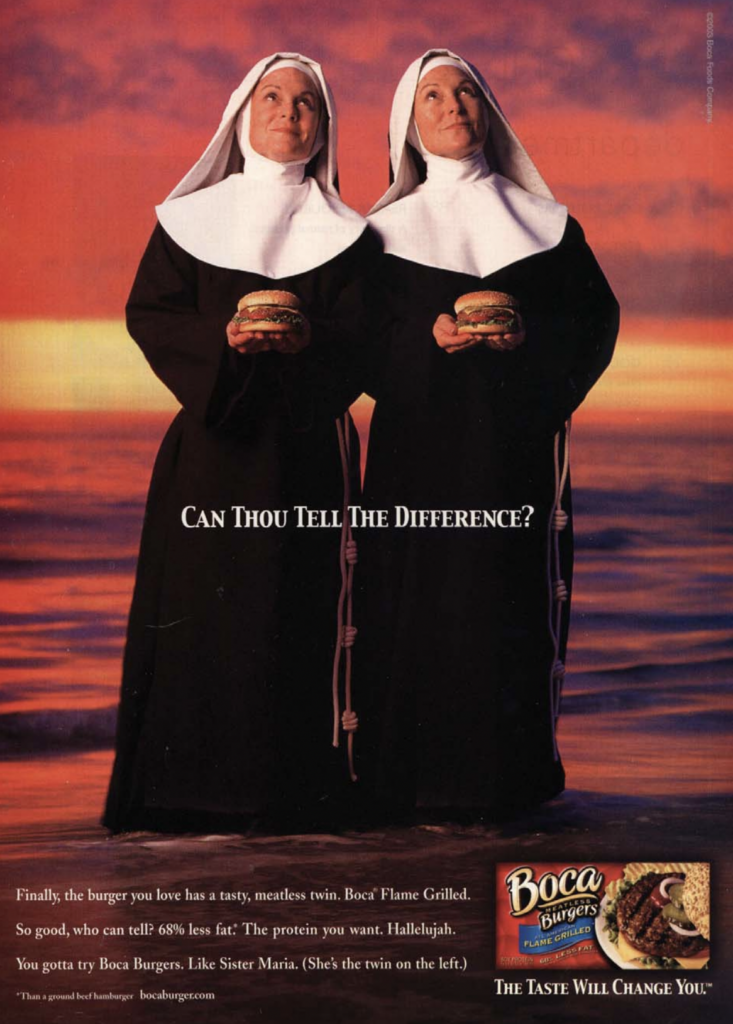Meal replacements as a category are essentially modern and almost certainly post-industrial in origin. Their deep roots and material entanglements are discarded or obscured in favor of the novelty and promise of meals unburdened by history, culture, or relations (in the broadest sense). It is useful to trace the contours of the meal replacement, to understand its function as a true meal replacement and not just the swapping or elimination of a single food or ingredient. A meal replaced does not result in a hole that immediately fills in, like dipping a cup into a body of water. Rather, the purposeful elimination of the meal in all of its relational complexity is swiftly replaced, either in a way which can enliven its host, enriching it with new relations, or with an interloper that discourages and even blocks the lively relations that constitute meals. A good example is the difference between Buddhist mock meats, which are used in replacement for animal products, and the anonymous shake containing the ‘necessary’ nutrients to sustain life (though the quality of that life is debatable). Meals are a space within which eaters are exposed to forces that either allow for a continuation of traditions or create alienation from them, and meal replacements operate as tools to produce either outcome.
Perhaps the most ubiquitous example of the meal replacement is Soylent — the once powdered, now premixed slurry for the desk-bound coder or working woman on the go. Its origins can be found deep within coder and tech culture. Founder Rob Rhinehart attributes the meal replacement’s inception to his experimentation with mixing various supplements and powders to facilitate fuel for long stretches of time coding in order to avoid taking breaks for meals. The product was named, at least in part, for the film Soylent Green though the company now (in conflict with old interviews with Rhinehart) emphasizes a sole association with the Soylent in the novel, Make Room! Make Room!, which served as a source text for the film. In the novel, Soylent is made only from algae, while in the film the titular Soylent Green (a kind of hard tack or ambiguous nutritional solid food) is made from people who (somewhat) voluntarily end their lives in a world of extreme overpopulation.
Culturally, the meal replacement aligns itself with the ascetic, a modern reproduction of the myth of the dignified hermit. This myth is characterized by a denial of culture through self-imposed isolation and transcendent alienation, one that produces a new culture founded upon that very alienation. A look at the lifestyles of ascetic individuals — monks, nuns, clergy, priests, and high level religious practitioners — reveal baroque and contested systems of eating which require essentially a professional commitment to keep track of and litigate. In contrast to the meal replacements of the diet hacker, fasting and dietary regulation in religious practice often reproduces further liveliness and more complex relationships. In many cases, excess is considered in direct opposition to piety, unless the excess can be repurposed for an act of generosity and emphasizes piety and devotion in some other way. Buddhist monks, for instance, will produce elaborate and accurate mock meats for festivals and visitors, but tend not to partake much of them themselves. More often than not, excess is defined as some combination of quantity of food in general and specifically the amount of meat or animal products present. Alliums (onion, garlic, etc) and other major flavor contributors are often discouraged for a range of religiously significant reasons: often to avoid an almost sexual arousal or just to subdue a general excess of stimulus.

These restrictive diets created frameworks and various scales of time, with feast and fast days entangled with agricultural practices, cooking methods, and politics and society writ large. Lent, for instance, was (and is) a temporal organizing force throughout the Christian world, with weeks of fasting exemplified by little to no meat, punctuated by feast days of abundance and extreme excess. Not exclusive to Christianity, feasting and fasting is found throughout religions with so many commonalities to seem almost a natural or inevitable aspect and expression of human life. Massimo Montanari succinctly ties the grammar of cooking with food’s role in delineating time through condiments: “The role of condiments is more like that of the adjectival or adverbial function of the grammar. The choice of condiments can actually be tied not only to economic reasons (the availability of resources), but also to rituals (in Christian Europe, the liturgical calendar and its obligations to eat lean or fat), which endow foods with the spatial temporal classification typical of adverbs. The option of lard versus oil, with the possible local variation of butter, signifies belonging to a region, to a society, to a culture, but also communicates the day, the week, and the time of year.” (Massimo Montanari, Food Is Culture)


Monastic kitchens of all kinds also tend to prefer certain methods of cooking over others, often preferring to cook foods via the mediator of water (boiling or steam), discouraging the use of direct flame as a heat source. The Shakers linked their food production and consumption inextricably with their religious practice, perhaps most clearly described in their famous line, “hands to work, hearts to god”. Though contemporarily more famous for their handicrafts, furniture, and architecture, their agricultural products and recipes were widely known at their peak in the mid-19th century. The labor of producing meals began for them with seeds which became a major source of income for the communities and ended with communal eating and the feeding of one another. This labor was considered an extension of their religious practice, with every lifting of a tool or stirring of a pot functioning as prayer. Through labor, worldly meals were transformed into holy communion. Now dwindling to a population of three (the Shakers are celibate), their religiously dictated foodways have been appropriated and sold in cookbooks and even in trendy restaurants such as The Commerce Inn in the West Village in Manhattan. This reproduction, plucked from its specific context, brings us to non-traditional diets. That is, diets that originate in a moment of alienation.
Non-traditional diets by definition refuse context and the liveliness of relations, some more successfully than others. Meal replacements and technology are historically intertwined, with developments in either category influencing innovation in the other. In the mid 20th century, for instance, military technology had a profound influence on the eating habits and material realities of an increasingly industrialized world. The introduction of flash freezing, microwaves, and de- and re-hydrated foods permeated domestic space and bellies, marketed for health or for women’s liberation or whatever else best sold the item or process in question. In the 20th century (through present day) hygiene and ease of preparation became major selling points for frozen or ready made and packaged foods, preying on an increasing fear of the “raw” (both visceral and existential) while also eroding entire generations of food preparation knowledge in order to create increasingly fearful, inept, and ultimately alienated consumers both within developed nations and as a colonial and imperial strategy abroad. Cut to present day with the ubiquity of subscription and membership based weight loss programs that distill eating to a points system, a promise of time travel or reversal with keto and primitive food diets, a repackaging and renaming of traditional foods, the introduction of the ‘cheat meal’, Home Meal Replacements (known in the professional trade as HMR’s), and a resulting horror vacui at the dinner table. The outcome is a loss of traditional diets in the severing of the traditional “handing over” etymologically alluded to: a coordinated and forced forgetting of embodied knowledge in service of capitalist accumulation. As Native activist Paula Gunn Allen puts it, “the root of oppression is loss of memory.” (Paula Gunn Allen, “Who Is Your Mother? Red Roots of White Feminism,” in Multicultural Literacy)

The cultural significance of meal replacements is best represented across science fiction and post-apocalyptic depictions of food systems and food technologies. Fictional meals in science fiction tend to more clearly reflect the curiosities and preoccupations of their respective time periods. The Foodarackacycle machine in The Jetsons, set in the year 2062, would spit out any food at the push of a button, with echoes of 1950s promises of hi-tech and increasingly automated home kitchens. Blade Runner 2049, set within a decade or so of the Jetsons, depicts grim protein farms and ambiguous gelatinous noodles overlaid with a holographic image of what they should taste like in homage to restaurant service depicted in the film Brazil (1985) set in a now future past 20th century byzantine bureaucratic state. Interestingly, Soylent the company is complicating, or even enlivening its offerings through a strange recipe section of their website with Soylent Energizing Chai Muffins and Soylent Protein Nachos made using soylent as an ingredient and not a replacement as originally intended. This newfound liveliness brings to mind Milo, a powdered malted drink common in Asia, in particular Malaysia, and was originally introduced to provide supplemental nutrition to children. Milo is now a cultural staple and has been all but completely assimilated into traditional cuisine. Maybe Soylent will become a nostalgic beverage in San Francisco at odds, and perhaps even defeating, its broader project of producing a generation of unquestioning and optimized consumers.
In defining the meal replacement, the simplest distinction between food replacement and meal replacements lies in the relations between their constituent parts, before, during and after their (human) digestion. In reality, a greater distance between the eater and the eaten is constructed with cumulative and increasing alienation from the material realities of the materials sourced and the waste generated, all sold to us at a premium. This is not to say that the ideal system with which to feed and be fed should occur at the level of the post-industrial and neoliberal institution of the nuclear family. There is significance in the difference between outsourcing production of meals to corporations and communal food preparation systems in which labor and materials are distributed among a group or community. The difference occurring in the space between gestures of buying/selling and receiving/giving.
⦂ “Vitello” “Tonnato” ⦂
2-3 teaspoons dulse flakes
1/4 cup silken tofu
2 tablespoons capers, drained
1 garlic clove
1 teaspoon miso paste
1 teaspoon soy sauce or vegetarian garum
3-4 tablespoons freshly squeezed lemon juice
1/4 cup plus 2 tablespoons extra-virgin olive oil
Blend ingredients for “Tonnato” sauce until smooth and season to taste.
Grill or roast slabs of eggplant, peppers, or oyster mushrooms, season lightly and arrange flat on a plate. Pour the sauce on top and garnish with additional capers. Serve room temperature or cold.












